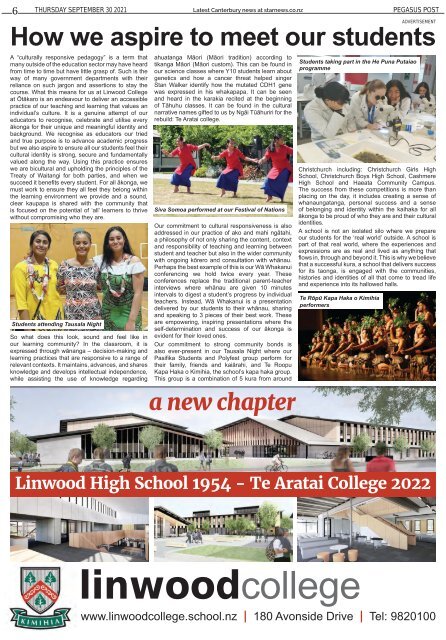Pegasus Post: September 30, 2021
Create successful ePaper yourself
Turn your PDF publications into a flip-book with our unique Google optimized e-Paper software.
6<br />
Latest Canterbury news at starnews.co.nz<br />
Thursday <strong>September</strong> <strong>30</strong> <strong>2021</strong><br />
PEGASUS POST<br />
ADVERTISEMENT<br />
How we aspire to meet our students<br />
A “culturally responsive pedagogy” is a term that<br />
many outside of the education sector may have heard<br />
from time to time but have little grasp of. Such is the<br />
way of many government departments with their<br />
reliance on such jargon and assertions to stay the<br />
course. What this means for us at Linwood College<br />
at Ōtākaro is an endeavour to deliver an accessible<br />
practice of our teaching and learning that values an<br />
individual’s culture. It is a genuine attempt of our<br />
educators to recognise, celebrate and utilise every<br />
ākonga for their unique and meaningful identity and<br />
background. We recognise as educators our tried<br />
and true purpose is to advance academic progress<br />
but we also aspire to ensure all our students feel their<br />
cultural identity is strong, secure and fundamentally<br />
valued along the way. Using this practice ensures<br />
we are bicultural and upholding the principles of the<br />
Treaty of Waitangi for both parties, and when we<br />
succeed it benefits every student. For all ākonga, we<br />
must work to ensure they all feel they belong within<br />
the learning environment we provide and a sound,<br />
clear kaupapa is shared with the community that<br />
is focused on the potential of ‘all’ learners to thrive<br />
without compromising who they are.<br />
Students attending Tausala Night<br />
So what does this look, sound and feel like in<br />
our learning community? In the classroom, it is<br />
expressed through wānanga – decision-making and<br />
learning practices that are responsive to a range of<br />
relevant contexts. It maintains, advances, and shares<br />
knowledge and develops intellectual independence,<br />
while assisting the use of knowledge regarding<br />
ahuatanga Māori (Māori tradition) according to<br />
tikanga Māori (Māori custom). This can be found in<br />
our science classes where Y10 students learn about<br />
genetics and how a cancer threat helped singer<br />
Stan Walker identify how the mutated CDH1 gene<br />
was expressed in his whakapapa. It can be seen<br />
and heard in the karakia recited at the beginning<br />
of Tāhuhu classes. It can be found in the cultural<br />
narrative names gifted to us by Ngāi Tūāhuriri for the<br />
rebuild: Te Aratai college.<br />
Siva Somoa performed at our Festival of Nations<br />
Our commitment to cultural responsiveness is also<br />
addressed in our practice of ako and mahi ngātahi,<br />
a philosophy of not only sharing the content, context<br />
and responsibility of teaching and learning between<br />
student and teacher but also in the wider community<br />
with ongoing kōrero and consultation with whānau.<br />
Perhaps the best example of this is our Wā Whakanui<br />
conferencing we hold twice every year. These<br />
conferences replace the traditional parent-teacher<br />
interviews where whānau are given 10 minutes<br />
intervals to digest a student’s progress by individual<br />
teachers. Instead, Wā Whakanui is a presentation<br />
delivered by our students to their whānau, sharing<br />
and speaking to 3 pieces of their best work. These<br />
are empowering, inspiring presentations where the<br />
self-determination and success of our ākonga is<br />
evident for their loved ones.<br />
Our commitment to strong community bonds is<br />
also ever-present in our Tausala Night where our<br />
Pasifika Students and Polyfest group perform for<br />
their family, friends and kaiārahi, and Te Roopu<br />
Kapa Haka o Kimihia, the school’s kapa haka group.<br />
This group is a combination of 5 kura from around<br />
a new chapter<br />
Students taking part in the He Puna Putaiao<br />
programme<br />
Christchurch including: Christchurch Girls High<br />
School, Christchurch Boys High School, Cashmere<br />
High School and Haeata Community Campus.<br />
The success from these competitions is more than<br />
placing on the day, it includes creating a sense of<br />
whanaungatanga, personal success and a sense<br />
of belonging and identity within the kaihaka for all<br />
ākonga to be proud of who they are and their cultural<br />
identities.<br />
A school is not an isolated silo where we prepare<br />
our students for the ‘real world’ outside. A school is<br />
part of that real world, where the experiences and<br />
expressions are as real and lived as anything that<br />
flows in, through and beyond it. This is why we believe<br />
that a successful kura, a school that delivers success<br />
for its taonga, is engaged with the communities,<br />
histories and identities of all that come to tread life<br />
and experience into its hallowed halls.<br />
Te Rōpū Kapa Haka o Kimihia<br />
performers<br />
Linwood High School 1954 - Te Aratai College 2022<br />
linwoodcollege<br />
www.linwoodcollege.school.nz | 180 Avonside Drive | Tel: 9820100


















